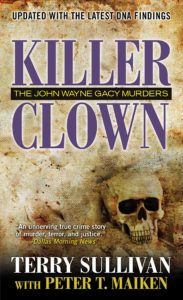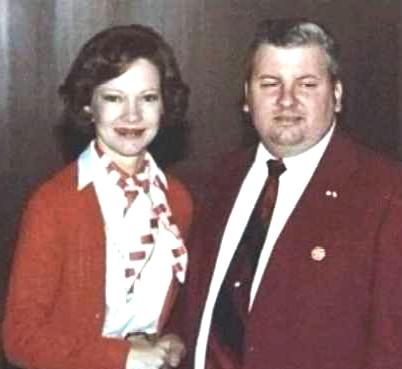Methodical and Chilling: The Story of John Wayne Gacy, Jr
Author: Terry Sullivan
John Wayne Gacy Jr – many have heard the name and know the basics of the story, a serial killer, famous for stowing his dead victims in his own house, and conversely playing a clown for children’s charities, but the actual details are far more chilling and meticulously executed than the lore. Killer Clown, despite its unfortunate B-movie name, is a serious and thorough account written by Terri Sullivan, the prosecutor in the famous 70s Gacy case. It begins with the disappearance of Gacy’s final victim and traces the action, from the police’s burgeoning suspicion, to Gacy’s strange behavior and criminal past, to the final arrest and confession, all in chronological order. It’s a slow burn at 400 pages, the grisly details only following after the minutely drawn investigation, but it nonetheless opens a question that can never be answered. What made Gacy do what he did – was he disturbed, distraught over something veiled in his past, or simply evil? We might close the book with our suspicions, but in this examination of a monster the final motives remain hidden, or perhaps too heinous, for revelation.
As one of my early dives into true crime fiction, an interest sparked by recently released If You Tell, I chose this book (an epic 14 plus hours on Audible) because I knew the Gacy case was both historic and horrific, but I knew nothing about it or about what compelled Gacy. Surprisingly, for the title and all the dwelling on his clown makeup, Gacy wasn’t clowning (literally) at the time, and instead he is described as a successful, if somewhat shady, contractor. Sullivan introduces him in the weird ways of nonfiction with literary aspirations. That facts are there, but we also shift perspectives as witnesses, police officers, and investigators juggle for the center stage. Through them, and the words of those who knew Gacy or interacted with Gacy, Sullivan reveals what Gacy was thought to be and all his chimera forms as the investigation continued. This bit is grueling for the thrill seeker, but intriguing for the reader interested in watching a small-town department land an unprecedented case. It also builds on the monotony of investigation, the criticality of seemingly minor details (who owns a particular TV for example), and the subtle line between the police and the not-yet accused. It also creates an interesting portrait of Gacy who is at times erratic, at other times cunning, boisterous and given to hyperbole, reckless and calculated– and obsessed with his sexuality, which was a key feature in the modus operandi of his crimes and the selection and dehumanization of his victims.
The difficult part of this cat-and-mouse game for the reader is the long list of names. The victims and their families, Sullivan captures with compassion, immortalizing them in the sad way of all those who die violently. The investigators and endless carousel of policemen are less easy for readers, even devoted ones, to keep separate. Quickly, we become overwhelmed by the multitude of names and who knew what, who suspected what, and who got what from the at times charismatic Gacy. Add to this list Gacy’s own shadowy cohort of (conspirators?) friends, and the name mix soon becomes alphabet soup with readers struggling to keep pace and focus on the slow reveal of Gacy’s actions.
 After the lengthy investigation, the book quickens as the police swarm Gacy’s house. The way they determine that his victims are hidden there is eerie happenstance and the slow unveiling of the extent of both his depravity and evil isn’t long winded, but it is certainly vivid and disturbing. Gacy’s own occasional revelations of where some harder to find bodies were located, plus the very magnitude of the discovery (requiring near dismantling of the house to access the teaming crawl space) are shocking in the way of a horror novel because even with the descriptions it’s a hard thing to wrap our minds around. A man killing is one step toward the devil many of us cannot understand, serial killing a leap straight to hell, but keeping bodies buried in the house, sleeping in a house filled with the tortured dead? Far better to imagine that as the plot of a movie than an actuality. And yet, there it is, one of the most appalling elements of the case. Sullivan, in his detailed format, doesn’t shy away from the description of what such a tomb looked and smelled like, nor the odd and discomfiting gallows humor it created among the excavators.
After the lengthy investigation, the book quickens as the police swarm Gacy’s house. The way they determine that his victims are hidden there is eerie happenstance and the slow unveiling of the extent of both his depravity and evil isn’t long winded, but it is certainly vivid and disturbing. Gacy’s own occasional revelations of where some harder to find bodies were located, plus the very magnitude of the discovery (requiring near dismantling of the house to access the teaming crawl space) are shocking in the way of a horror novel because even with the descriptions it’s a hard thing to wrap our minds around. A man killing is one step toward the devil many of us cannot understand, serial killing a leap straight to hell, but keeping bodies buried in the house, sleeping in a house filled with the tortured dead? Far better to imagine that as the plot of a movie than an actuality. And yet, there it is, one of the most appalling elements of the case. Sullivan, in his detailed format, doesn’t shy away from the description of what such a tomb looked and smelled like, nor the odd and discomfiting gallows humor it created among the excavators.
Finally, the trial arrives, and Sullivan lays out what is on the line and the precedents set by the case. Gacy’s own attorneys wanted to plead insanity – after all, what sort of a man lives happily among decaying bodies, yet Sullivan more than makes his point (here’s where the long intro truly comes to the forefront) that this case is not one of brokenness but one of evil, and planned evil at that. Here, Sullivan tells us of Gacy’s own odd pride, and continual thwarting of his attorneys, the reaction of the jury, and a summation of the biggest court room moments. He ends it all with an afterward, an uncomfortable moment where all these years later, his career made by this case, he still has no answers to some of the biggest questions: why did Gacy do this, did Gacy act alone, how many others were never found, and how deep will this legacy of horror go? Perhaps the world wasn’t necessarily a less safe place after Gacy was found, but it was revealed for what it was and the illusion of security, once shattered, can’t be returned.
– Frances Carden
Follow my reviews on Twitter at: https://twitter.com/xombie_mistress
Follow my reviews on Facebook at: https://www.facebook.com/FrancesReviews
[AMAZONPRODUCTS asin=”0786032545″]
- Book Vs Movie: The Shining - April 6, 2020
- Thankful For Great Cozy Mysteries - December 13, 2019
- Cozy Mysteries for a Perfect Fall - October 20, 2019




